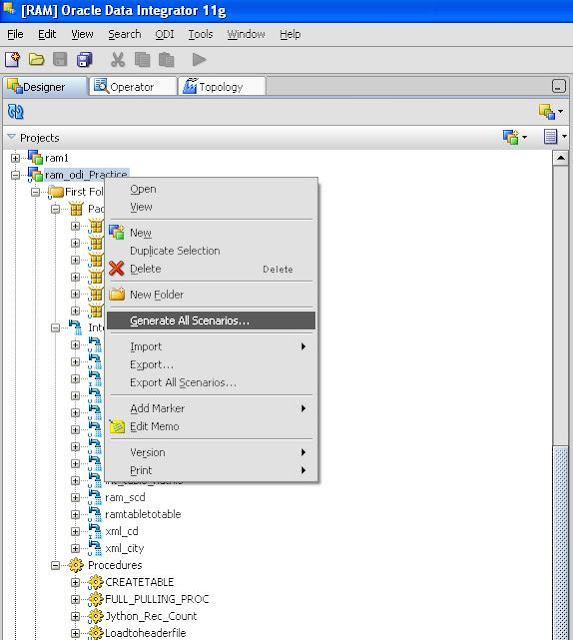Organizing the Project with Folders
In a project, interfaces, procedures and packages are organized into folders and sub-folders. It recommended to maintain a good organization of the project by using folders. Folders simplify finding objects developed in the project and facilitate the maintenance tasks.
Creating a New Project
create a project:
In Designer Navigator, click New Project in the toolbar of the Projects accordion.
Enter the Name of the project.
Keep or change the automatically-generated project Code. As this code is used to identify objects within this project, it is recommended to make this code for a compact string. For example, if the project is called Corporate Datawarehouse, a compact code could be CORP_DWH.
From the File menu, click Save.
The new project appears in the Projects tree with one empty folder.
Project Life Cycle
The project life cycle depends on the methods and organization of your development team. The following steps must be considered as guidelines for creating, working with and maintaining an integration project.
Create a new project and import Knowledge Modules for this project.
Define the project organization and practises using folders, markers and documentation.
Create reusable components: interfaces, procedures, variables, sequences. Perform unitary tests.
Assemble these components into packages. Perform integration tests.
Release the work in scenarios
Oracle Data Integrator Project Components
The following components are stored into a project. The appear in the in the Project accordion in the Designer Navigator, under the project's node.
Folder
Folders are components that help organizing the work into a project. Sub-folders can be inserted into folders. Folders contain Packages, Interfaces and Procedure.
Packages
The package is the largest unit of execution in Oracle Data Integrator. A package is a workflow, made up of a sequence of steps organized into an execution diagram. Packages assemble and reference other components from a project such as interfaces, procedure or variable.
Interface
An interface is a reusable dataflow. It is set of declarative rules that describe the loading of a datastore or a temporary target structure from one or more source datastores
Procedure
A Procedure is a reusable component that groups a sequence of operations that do not fit in the interface concept.
Examples of procedures:
wait and unzip a file
send a batch of files via FTP
receive emails
purge a database
Variable
A variable's value is stored in Oracle Data Integrator. This value may change during the execution.
Sequence
A sequence is an variable automatically incremented when used. Between two uses the value is persistent.
User Functions
User functions enable to define customized functions or "functions aliases", for which you will define technology-dependant implementations. They are usable in the interfaces and procedures.
Knowledge Modules
Oracle Data Integrator uses Knowledge Modules at several points of a project design. a Knowledge Module is a code template related to a given technology that provides a specific function (loading data, reverse-engineering, journalizing).
Marker
Component of a project may be flagged in order to reflect a methodology or organization. Flags are defined using the markers. These markers are organized into groups, and can be applied to most objects in a project.
Scenario
When a package, interface, procedure or variable component is finished, it is compiled in a scenario. A scenario is the execution unit for production. Scenarios can be scheduled for automated execution
Global Components
Global components are similar to the project objects. The main different is their scope. They have a global scope and can be used in any project. Global objects include Variables, Sequences, Markers and User Functions.
MONDAY, 9 MAY 2011
Generate all scenarios in a project
Dear Guru's,
Today we are going to discuss a good concept of ODI11g.
There are some situations we may require to generate all scenarios for the following objects of a project
Go to the designer.
Select the required project to generate scenarios for.
Right click on the project name
click on generate scenarios.

Then the following window appears.
Then select the objects you want to generate scenarios.
click ok.
Today we are going to discuss a good concept of ODI11g.
There are some situations we may require to generate all scenarios for the following objects of a project
- all interfaces
- all procedures
- all packages
- all interfaces and procedures
- all interfaces and packages
- all procedures and packages
- all interfaces, procedures and packages
Go to the designer.
Select the required project to generate scenarios for.
Right click on the project name
click on generate scenarios.

Then the following window appears.
Then select the objects you want to generate scenarios.
click ok.
In this way we can generate all scenarios at a time.
Thanks Guru's
Ram Kumar Lanke
 22:02
22:02
 RAM KUMAR LANKE
RAM KUMAR LANKE




0 comments:
Post a Comment